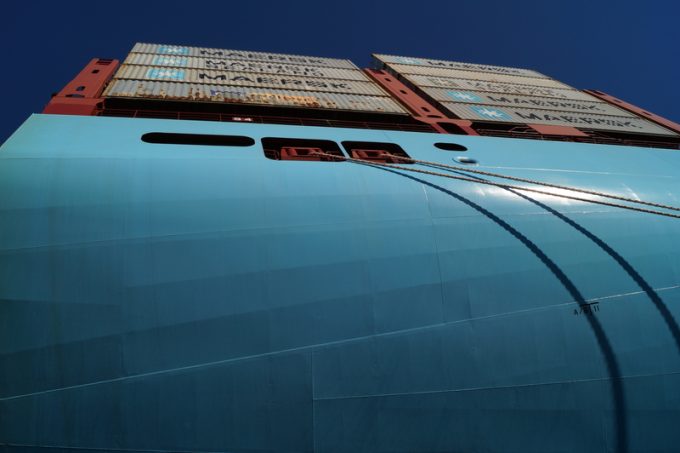Maersk expects profit hike on strong demand and Red Sea crisis
AP Møller-Maersk has raised its full-year earnings guidance amid “strong container market demand”. The Danish ...
GM: RAISING THE ROOF GGM: IN FULL THROTTLE GZIM: MAERSK BOOST KNIN: READ-ACROSSMAERSK: NOT ENOUGHMAERSK: GUIDANCE UPGRADEZIM: ROLLERCOASTERCAT: HEAVY DUTYMAERSK: CATCHING UP PG: DESTOCKING PATTERNSPG: HEALTH CHECKWTC: THE FALLGXO: DEFENSIVE FWRD: RALLYING ON TAKEOVER TALKODFL: STEADY YIELDVW: NEW MODEL NEEDEDWTC: TAKING PROFIT
GM: RAISING THE ROOF GGM: IN FULL THROTTLE GZIM: MAERSK BOOST KNIN: READ-ACROSSMAERSK: NOT ENOUGHMAERSK: GUIDANCE UPGRADEZIM: ROLLERCOASTERCAT: HEAVY DUTYMAERSK: CATCHING UP PG: DESTOCKING PATTERNSPG: HEALTH CHECKWTC: THE FALLGXO: DEFENSIVE FWRD: RALLYING ON TAKEOVER TALKODFL: STEADY YIELDVW: NEW MODEL NEEDEDWTC: TAKING PROFIT

Tougher market conditions, due to lower freight rates and higher fuel costs in the final quarter, meant that Maersk Line missed its full-year profit target.
Maersk Group’s guidance – which it reiterated in November – was for an improvement of around $1bn for the carrier, which lost $384m in 2016.
And despite the Petya cyber attack in the summer, Maersk was confident it could still achieve its guidance.
However, requiring a modest $158m profit in the fourth-quarter, Maersk Line surprised analysts by recording a surplus of just $91m on a turnover of $6.1bn for a very disappointing return on sales of 1.8%.
Freight rates on the east-west trades tumbled to their lowest level of the year, resulting in an average of $2,016 per feu as the carrier struggled to fill its ships.
Thus, for full-year 2017, it posted a net profit of $521m on revenue of $23.8bn, thereby achieving a return on sales of 2.9%.
Explaining the setback, during its annual results presentation today, Maersk Line chief commercial officer Vincent Clerc said there had been a $214 per feu average rate erosion between the second quarter and the end of the year.
Mr Clerc added that the carrier was paying the equivalent of $60 per feu more in fuel costs at the end of 2017 than at the beginning of the year.
Maersk included its Hamburg Süd subsidiary in its accounts from 1 December, but the Latin American specialist could only contribute a loss of $8m in the final month on $458m turnover. However, group chief executive Soren Skou said it would be wrong to read too much into one month’s trading.
He said a pro-forma calculation for the Hamburg-based carrier would have shown a profit of $85m from sales of $5.4bn.
Mr Skou reconfirmed expectations of cost synergies of $350-$400m a year by 2019 from the acquisition of Hamburg Süd.
He added that although east-west rates remained under pressure, north-south freight rates – where Hamburg Süd has most of its business focus – were holding up well.
However, he conceded that Maersk expected “some retention loss” from the merging of the businesses and that growth in the integrated trades would be “slightly below” the industry level.
Meanwhile, APM Terminals reported a fourth-quarter profit of $108m, gained from a 6.8% increase in throughput at its facilities, compared with the same period of the year before, to 10.3m teu.
Mr Skou said that APMT had gained from a “strong collaboration with Maersk Line” with the synergy benefit put at $100m.
APMT saw its annual throughput increase from 37.3m teu in 2016 to 39.7m teu last year. However, due to impairments at its terminals, APMT recorded a full-year loss of $168m in 2017, although its underlying profit was $414m.
It said that it had “won” five commercial contracts in the fourth quarter and lost just one.
Maersk’s forwarding arm, Damco, lost a further $21m in the final quarter, to put it $35m in the red for the 12-month period.
“It was a difficult, unsatisfactory year for Damco,” said group chief financial officer Jakob Stausholm, adding that the forwarding unit had taken longer than Maersk Line to recover from the cyber attack.
Comment on this article